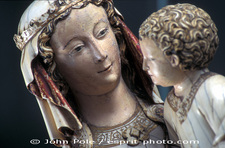Jesus, gentle and humble of Heart,
You are the Bread of Life;
help me to live my life hidden in Your Eucharistic Heart
in the Presence of our Father
united in the love and power of Your Holy Spirit.
Give me a listening heart,
a heart to love You for Your own Sake, to love You in myself,
and to love You in my brothers and sisters as You have
loved.
Consume me in the fire of Your love.
Mary, Mother of the Incarnate Word and my Mother,
you are the first “house of bread.”
Help me to live in perfect love by being:
the bread of Humility and Abandonment to the Father’s will;
the bread of Sincerity and Truth,
the bread of Purity of Heart;
the bread of Word and Eucharist;
the bread of Simplicity, Poverty and Littleness;
the bread of Silence and Solitude;
the bread of Prayer and Contemplation;
the bread of Reconciliation and Peace;
the bread of Interior and Joyful Suffering;
the bread of Charity and Desert Hospitality,
broken and offered with Jesus to the merciful Father
and shared for the salvation of the world.
Holy Mary, Lady of Bethlehem, Queen of the Desert,
guide me in the journey of the Spirit that, together with you,
I may participate in the wedding feast of the Risen Lamb
until at last I may sing an eternal Magnificat of Love and
Praise,
face to Face, before our All-Holy Triune God. Amen.
A Way of Desert Spirituality: The Plan of Life of the
Hermits of Bethlehem
Father Eugene L. Romano, Founder of the Hermits of
Bethlehem, Chester, New Jersey




